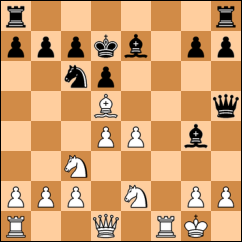W.Engel–G.Sargent
Route 20 Open
Freeport, Ill., Jan. 15, 2011
1.e4 e5 2.Bc4 Nc6 3.d3 d6 4.f4 exf4 5.Bxf4 Ne5 6.Bb3 Qf6
6...Bg4 does more to keep Will in his place.
7.Ne2 Ne7?
Passive. 7...Bg4 is still strong, and it allows speedy queenside castling.
8.0-0 N7c6
At this point, there's nothing stopping Will from playing d4; the square is well covered. By playing ...N7c6, Gary prevents himself from suppressing the advance with ...c5.
9.Nbc3 Bg4 10.Bxe5
After 10.d4 Ng6 11.Be3, white has almost completed his development, while black is struggling to keep his balance.
10...Qxe5 11.Bxf7+ Kd7 12.Bd5 Be7 13.d4 Qh5
14.e5??
After 14...dxe5 15.Qd3 Kc8 16.Bxc6 bxc6, white's initiative has fizzled. With 14.Qd3 Kc8 15.Bxc6 bxc6 16.Qa6+ Kb8, the position is similar, but with one significant difference: white still has center control, with both his d- and e-pawns.
14...Bxe2?
Gary hesitates to blow up the center, and Will gets a reprieve.
15.Nxe2
As opposed to the clumsy 15.Qxe2?! Qxe2 16.Nxe2 dxe5, after which white's attacking power has evaporated.
15...Raf8 16.e6+
Will also has the sly 16.Be6+!, after which 16...Kxe6 is impossible because 17.Nf4+ wins Gary's queen.
16...Kd8 17.Bf3 Qg5 18.Qc1
Despite being down a pawn, it's in Gary's interest to trade queens, for two reasons. First, his position is full of soft spots that Will's queen can target, and the game is closer without her. Second, if by some fluke Will answers 18...Qxc1 with 19.Nxc1 (as opposed to the sound reply 19.Raxc1) then 19...Nxd4 20.Nb3 Nxf3+ 21.Rxf3 Rxf3 22.gxf3 Rf8, and the tables are turned. A better move is 18.Qd3, with the same idea as at move 14.
18...Qh4 19.Bxc6 bxc6 20.Qe3 Rf6
A half-measure. Will is not going to be afraid of doubled black rooks. Better is 20...Rxf1+ 21.Rxf1 Rf8, threatening 22...Rxf1 23.Kxf1. Yes, Gary is still a pawn down. But clear the decks of rooks, and the position begins to look faintly drawish. If only the queens can be traded off as well . . .
21.d5 c5 22.g3
Will passes up a freebie in 22.Qa3 and 23.Qxa7.
22...Qc4 23.Qb3 Qxb3
Better to trade rooks first: 23...Rxf1+ 24.Kxf1 Rf8+ 25.Kg1 Qxb3 26.axb3.
24.axb3 Rhf8 25.Rxf6
A bit rash. 25.Nf4!? thumbs its nose at the doubled rooks and proceeds to run circles around black: 25...Kc8 26.Rxa7 g5 27.Ra8+ Kb7 28.Rxf8 Rxf8.
25...Bxf6 26.Rxa7 Bxb2 27.Ra8+ Kxf8
Similar to the end result of the variation above, except that all the rooks are gone, black's bishop look better, and white's knight looks worse.
29.c3 Ba3
29...Ke7 seems like a sensible precaution.
30.Kf2 Ke7 31.Ke3 c6 32.Ke4
32.dxc6!? isn't a silver bullet, but it does head off Gary's next move.
32...cxd5+ 33.Kxd5 g5 34.h3 h6 35.h4 Bb2 36.h3 Ba3 37.g4 Bb2 38.b4! cxb4 39.cxb4 Ba3 40.Nd4 Bxb4 1-0
It's over. After 41.Nc6+!! Kf6 42.Nxb4 Ke7 43.Nc6+, the e-pawn will inevitably promote.












